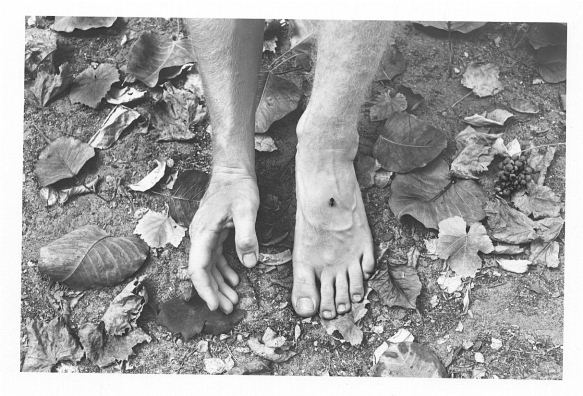
A stigmata piercing a human foot, a man’s torso twisted into a cruciform position, depictions of murdered geese, these are some of the unforgettable images featured in the photographs of Pesi Girsch. On display in an eight-person exhibition with an unusual theme – The Absent Body – Between Judaism and Christianity – they are telling examples of this Israeli artist’s dialogue with the story of Jesus and Christian art. This dialogue is a feature of almost all the other works on exhibit in a show that demonstrates the adherence of this group of secular artists to the Jewish concept of God as a body-less divinity, but also reveals influences on their art stemming from Christian belief in God’s manifestation in human form.
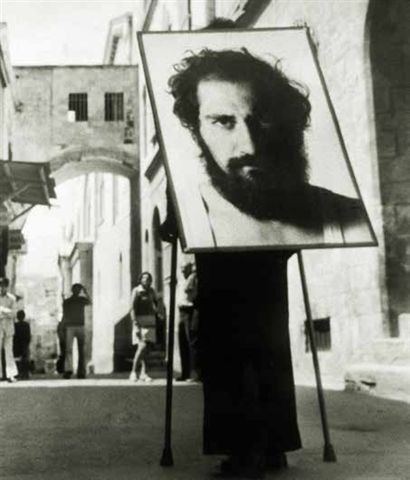
Three artists, Motti Mizrachi, Moshe Gershuni, and Michael Na’aman are showing works from the conceptual era of the1970s, as well as contemporary examples. One of the country’s first performance artists, Mizrachi, a cripple who walks with the aid of crutches, created his own Via Dolorosa (1973). A memorable photograph taken in the old city of Jerusalem shows him with a huge placard of his own bearded face strapped to his back as he traces the path that Jesus took on the way to Cavalry.
Mizrachi is known today for sculptures in which winged but always earthbound figures strive to break free. Representing this group of works is Marduk, a representation of a Babylonian god, a small, unexceptional piece. In contrast, his wall work Dominus, Spriritus, Sanctus (2000) makes a strong impression. Comprising three Plexiglas boxes set one within another, it illustrates perfectly the concept of the spirit devoid of matter.
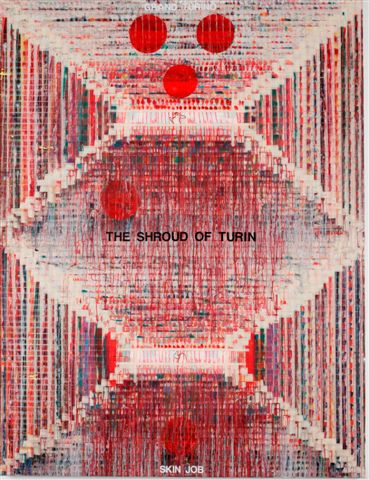
Na’aman was one of Israel’s first artists to combine texts and visual imagery in her paintings, many of which explore ways of materializing God’s divinity. Displayed here is a very early work: I Koheleth have been King over Israel in Jerusalem –for which Na’aman has handwritten the complete text of Ecclesiastes onto her canvas. Floating above the text are the softly delineated figures of angels or cherubs.
From the last two decades are examples of her immaculately ordered collage paintings. Incorporating masking tape, they produce the effect, particularly where red paint is used, of flayed or wounded flesh. One outstanding work is the monumental The Shroud of Turin, the reference being to a centuries old linen cloth bearing the image of a crucified man, claimed to be that of Jesus of Nazareth.
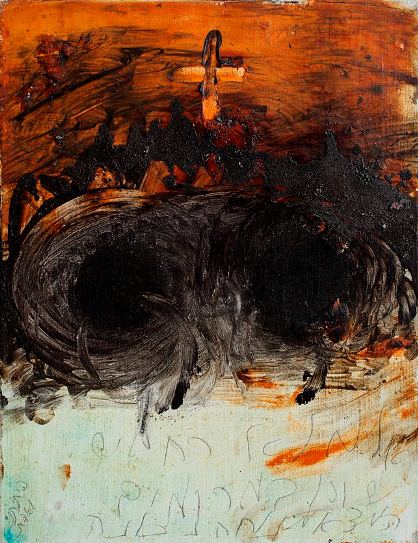
In Gershuni’s paintings, invariably created by smearing his materials by hand directly onto the canvas, connections are consistently made between the blood of Christ and the Holocaust, or else the loss of young life in battle. In one picture on view, given the ironical title God Full of Mercy, (the same words are scrawled across the painting) a cross is set before a blazing inferno.
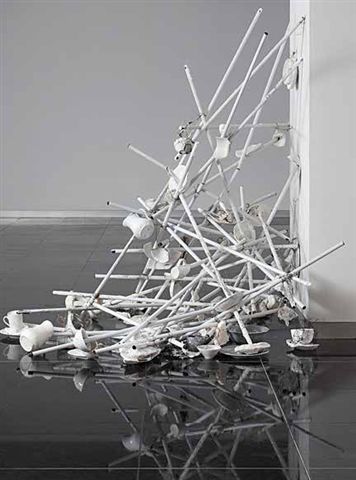
The body is replaced by a void in Abergel‘s sculptures: an old boot stuck into plaster, a set of containers – a bag, a basket and suitcase – giving the impression of having been abandoned by their owners. Her installation 100 heart beats comprises shards of china affixed to a configuration of sticks clustered round a vertical pole. It appears to be an attempt to give visual expression to Shevirat Ha-Kelim (The Shattering of Vessels,) a Chassidic belief regarding the creation and destruction of the world and its rebuilding through the process of Tiqqun. This work cannot but invite comparison with a far more striking take on the same subject mounted recently at the Tel Aviv Museum by the German artist Anselm Kiefer. While not a Jew, he refrained from incorporating figurative elements into his work, creating instead a symbolic memorial with Holocaust associations: metal shelves filled with hollow books and a floor strewn with broken glass. Chalked on the wall above it, were Cabbalistic signs representing infinity.
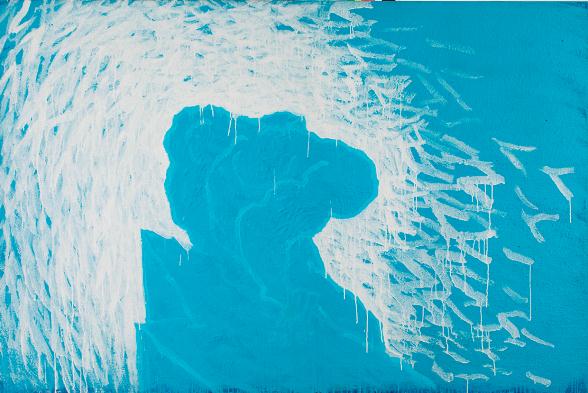
Among the small collection of works displayed by Larry Abramson, there is one piece that also might be viewed as a memorial. Titled Succah IV (2009), this is a minimalistic composition, painted onto a canvas in the form of a long horizontal rectangle. One sees nothing more than the shadow of palm leaves, but set behind two vertical strips of color, they take on the appearance of a holy relic.
One canvas on view is taken from Nevo (1984-95) Abramson’s first major painting series. Inspired by the story of Moses on Mount Nebo looking down on the Promised Land, Abramson conceived this scene as a vaguely defined blue silhouette of a human figure surrounded by whirls and sparks of white. Like many of his later works, this painting possesses a certain spirituality, in line with Abramson’s yearning to express the sublime through his art.
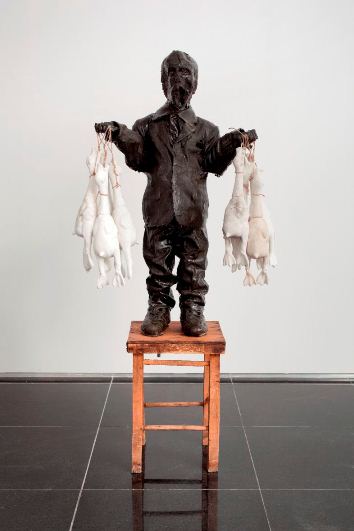
Erez Israeli sees his own body as that of a victim. In a photo titled Kokosh (Self-portrait at the age of 30) he exposes his chest which is marked by red wheals. The suffering that Israeli endured to get this effect (feathers stuck to his chest were plucked out) recalls both the Christian stigmata and the Jewish ritual of Kapparot. Associations with this act are also to be found in Shochet, a small fiberglass sculpture of a man holding lifeless chickens in both hands. But beyond this, this figure succeeds in being an effective metaphor for violence perpetrated on defenseless individuals.
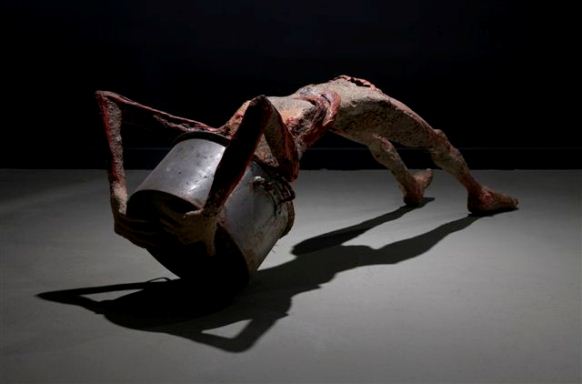
Raw flesh is also the effect given by the lean, muscular figures that Sigalit Landau constructs from wire and papier maché. They inhabit all her large installations, shown in Israel or abroad, which critique contemporary life in Israel. Dining Hall, mounted in 2007 at the KW Institute for Contemporary Art, Berlin, included scenes where gluttony was the main theme. A typical figure, shown here, has his body arched backwards, and head stuck in a metal bucket. This image, and others by Landau, bring to mind medieval depictions of punishments meted out to the wicked in Hell.
As demonstrated by Gideon Ofrat in his erudite catalog text, there was justification for mounting a much larger exhibition, a historical-chronological round-up of works by scores of local artists dealing with the body, its presence, absence or defilement, and relationship to Christian iconography. But curator Irena Gordon rightly chose to limit her choices. The result is a tightly knit, high quality selection that does her subject credit.
Beit Hatfutsot, The Museum of the Jewish People, till November 12, 2012.
.






[…] tape on canvas. Collection of Gordon Gallery, Tel Aviv. Photo credit: Avraham Hay. Source: Midnight East and Wikipedia […]
Comments are closed.